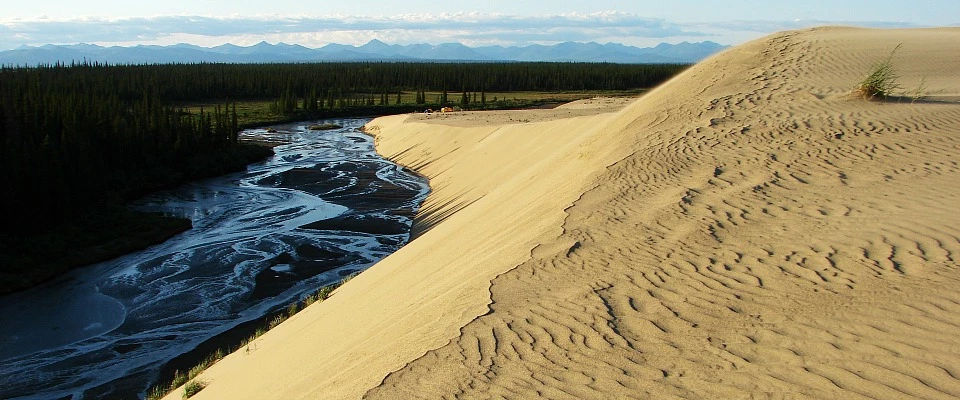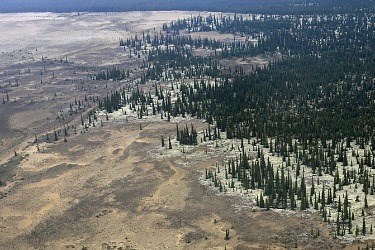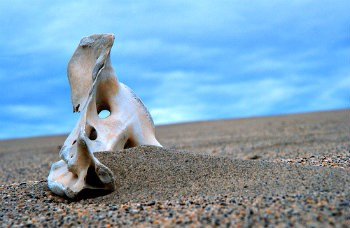
NPS Photo One of Kobuk Valley National Park's most iconic sights is the Great Kobuk Sand Dunes rising unexpectedly out of the tundra and trees. These dunes – the largest active sand dunes in the Arctic – along with the smaller Little Kobuk Sand Dunes and Hunt River Sand Dunes create 30 square miles of towering sand that would look more at home in the Sahara than 35 miles above the Arctic Circle. 
NPS Photo/Emily Mesner Relic from the PastKobuk Valley’s sand dunes are a relic of the last Ice Age. 28,000 years ago, the Earth cooled and glaciers began to form high in the mountains surrounding the valley. Over time, the slow, grinding advance and retreat of the glaciers ground the rocks beneath them into a fine sand which was blown by the wind into the sheltered, ice free Kobuk Valley. When the glaciers began to retreat 14,000 years ago, they left behind 200,000 acres of rolling sand dunes along the banks of the river. Over time, however, vegetation has reclaimed all but 16,000 acres of the sand, and continues to slowly eat away at the margins of the dunes. Sparse grasses, sedges, wild rye and the occasional wildflower, including the Kobuk locoweed which is only found on the slopes of Kobuk Valley’s sand dunes, grow in the shifting sand of the dunes. These plants stabilize the sand and pave the way for a succession of mosses and algae, lichen and shrubs before the aspen, birch and spruce of the forest take root. 
NPS Photo Life on the DunesLife is abundant on the fringe of Kobuk Valley’s dunes. Black and grizzly bears, wolves, foxes, porcupines and moose call the surrounding woods and tundra their home. It is common to see tracks and other signs of their passage in the sand along the edges of the dunes. Most dramatically, the mighty Western Arctic Caribou Herd passes through Kobuk Valley twice a year on their annual migration to and from their calving grounds north of the Brooks Range. During the spring and fall, the Great Kobuk Sand Dunes are marked with their hoof prints. Humans have also made Kobuk Valley’s dunes their home. People have lived in Kobuk Valley for at least 8,000 years, primarily on the banks of the fish-filled Kobuk River, but they also relied on the unique landscape of the sand dunes to hunt large animals. Evidence of hunting camps dating back thousands of years dot the edge of the dunes. Today, the Great Kobuk Sand Dunes, the largest and most accessible of the three dune fields, is 25 square miles of shifting, golden sand located just a couple of miles south of the Kobuk River, near the eastern boundary of the park. Soaring dunes reach 100 feet into the air and even though it is located in the Arctic, summer temperatures can be extreme, reaching 100 degrees. Visiting the Great Kobuk Sand Dunes is an unforgettable experience, but it is important to make sure to be well prepared for a backcountry excursion and respectful of Native inholdings and local subsistence practices. Visiting the Great Kobuk Sand DunesThe Great Kobuk Sand Dunes are a popular destination for hiking and camping. Aircraft on wheels can land right on the sand. Tents can be set up on any level surface and day hiking in any direction is feasible. An alternative is to land on the Kobuk River in a float plane and backpack two miles across the tundra up to the dunes. Getting there is an orienteering exercise that takes about 4 hours round trip from the river to the dunes. Contact the Northwest Arctic Heritage Center in Kotzebue for more specific route information at 907.442.3890. There is no marked route, so good orienteering skills are required. See the video on trip logistics to the dunes to help plan an excursion. Use caution around water-saturated sand!In parts of the Great Kobuk Sand Dunes, especially near creeks, streams, springs, and other water sources, sand can become saturated with water and lose its stability. This phenomenon, sometimes called "quicksand," causes the sand to behave more like a liquid than a solid, making it difficult to walk on and potentially hazardous. Always stay alert when hiking near the edges of water bodies in the dune fields. Test the ground ahead of you with a walking stick and avoid venturing into areas where the sand appears overly wet or unstable. |
Last updated: April 30, 2025
